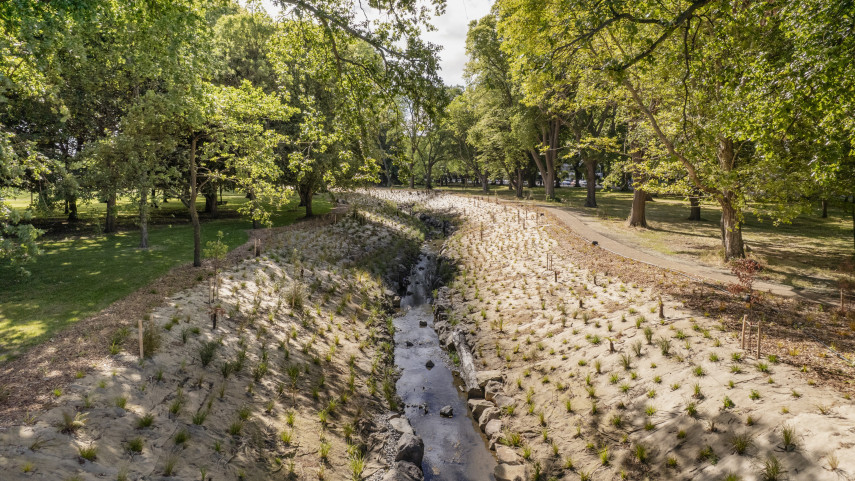Adopted By Council 23 November 2017.
1 Background
1.1.Much of Christchurch city is built on low lying land and there is extensive urban settlement close to rivers and the coast. Some communities were vulnerable to flooding prior to the Canterbury earthquake sequence.
1.2. The earthquakes have affected the frequency and severity of flooding on many properties as a result of:
- extensive areas of land subsidence
- reduced capacity in parts of rivers and streams
- damage to stormwater infrastructure.
1.3. Since the earthquakes there have been several flood events that have resulted in habitable floor flooding of residential properties in parts of Christchurch, and has
- adversely affected the health and well-being of people living in these properties
- created uncertainty or greater expense for obtaining insurance for home and contents of affected properties.
1.4. The Land Drainage Recovery Programme (LDRP) was established by Council in 2012 to understand the consequences of the earthquakes on the land drainage network. The LDRP includes over 100 projects of extensive investigations and capital works for floodplain management.
1.5. This policy amends the Flood Intervention Policy adopted by the Council on 10 December 2015 to provide clarity on the purpose and applicability of the policy.
2. Purpose
2.1. The purpose of this policy is to intervene when the Council’s engineering works will not be timely or effective in reducing risk of frequent flooding of habitable floor levels exacerbated the earthquakes.
2.2. This policy only applies to properties that meet all of the criteria specified in section 4 of this policy.
2.3. This policy addresses health and well-being concerns for people living in water damaged homes including the stress associated with frequent flooding events and the difficulty in obtaining affordable insurance cover.
2.4. This policy is a part of the Council’s integrated ‘all-hazards’ approach to floodplain management.
2.4.1. Flooding is not considered in isolation to other hazards, but rather it is addressed in the wider context of the risk from all natural hazards.
2.4.2. This is an important part of ensuring that decisions made now enable the city to adapt to the impacts and consequences of natural hazards.
3. Definitions
3.1. ARI: Average recurrence interval flood event.
3.2. Best value intervention option: How well the intervention option aligns with the broader floodplain management approach(es) for the catchment in which the property is located, based on a multi-criteria assessment based on factors such as:
- conveyance channels for high-flow flood events
- resilience and robustness
- impact on ecology, landscape heritage and culture
- whole-of-life cost
- whether the property is located in a High Flood Hazard Management Area as identified in the District Plan
- delivery risk, such as potential for unforeseen structural conditions.
3.3. Catchments: The drainage area into a stream or river; examples include the Dudley Creek, Avon River, Heathcote River and Styx River catchments.
3.4. Christchurch urban area: Urban and suburban areas within Christchurch city limits and excluding rural areas and Banks Peninsula settlements.
3.5. Earthquakes: The 2010-2011 Canterbury earthquake sequence and related aftershocks.
3.6. EQC: Earthquake Commission.
3.7. Frequent flooding: A one-in-ten ARI flood event; otherwise called a ‘one in ten year event’, or a flood level that has a ten percent chance of happening in any given year.
3.8. Habitable floor: Habitable areas of a dwelling, also referred to as ‘above floor’; excludes structures such as garages, laundries, detached sleep outs, utility areas, and unconsented buildings or alterations.
3.9. HFHMA: High Flood Hazard Management Area
3.10. LDRP: Council Land Drainage Recovery Programme.
3.11. Local drainage works: Engineering works that mitigate risk for a single property or at a neighbourhood scale.
3.12. Pre-existing flood risk: Where a property was considered prone to frequent flooding prior to the earthquakes and there is no evidence of exacerbation of the flood risk due to the earthquakes.
3.13. Timely and effective catchment engineering works: Engineering works that mitigate frequent habitable floor flooding. Determination of timeliness is at the Council’s discretion, to include factors such as:
- Current flood risk level (i.e. even greater risk than the one-in-ten ARI)
- Timeframes until catchment works are programmed to be investigated and/or completed
- Number of times flooding has occurred above habitable floor levels since the earthquakes
- Dwelling unsafe for occupation due to flood damage.
4. Applicability
4.1. Where habitable floor levels of residential properties are at increased risk of frequent flooding due to the Canterbury earthquake sequence, the following policy will apply.
4.2. The policy applies to eligible residential properties that meet all of the following criteria:
- are within Christchurch city urban area; and
- are at risk of frequent flooding of habitable floor levels as confirmed by Council modelling and a survey of the floor level, or have experienced frequent flooding of habitable floors; and
- where there has been earthquake exacerbation of flood risk, as assessed by: eligibility for Earthquake Commission (EQC) Increased Flooding Vulnerability and/or by Council flood assessment; and
- do not benefit from timely and effective catchment engineering works; and
- where dwellings will not be rebuilt or undergo a foundation repair such that the floor level will be raised to comply with the Building Code.
5. Intervention options
5.1. Under this policy the Council intervention options are local drainage works, house raising and an offer to purchase the property.
5.2. The Council will decide the ‘best value’ intervention option for an eligible property on a case by case basis. Intervention offers are voluntary and do not have to be accepted by the property owner.
5.3. The Council will manage interventions for eligible properties on a catchment by catchment basis to complement the investigation of engineering options to mitigate the flood risk as part of the Land Drainage Recovery Programme.
5.4. The financial assistance for local drainage works and/or house raising will be reduced by the amount of any EQC Increase Flooding Vulnerability payment that has been received for the property or is due to the property owner.
5.5. At the Council's discretion, a voluntary purchase offer to the current owner will be based on the higher of either:
- the 2007 capital valuation less any EQC payments and with assignment of insurance claims – as for the Port Hills red zone option 1; or
- The market valuation of the property, which will be obtained by the Council from an independent valuer, at the date of the Council’s offer, without assignment of the insurance and/or EQC payments.
5.6. A voluntary purchase offer will be capped at $750,000 per freehold property and $500,000 per strata or cross lease title property.
5.7. Any purchase offer made will be valid for 12 months from the date that the offer is made.
5.8. Following voluntary purchase the dwelling would be removed (demolished or relocated).
5.8.1. Where Council ownership of the land would provide benefits in terms of floodplain management (such as providing for high flow conveyance, stormwater ponding or wetland treatment) the property will be retained by Council.
5.8.2. Where any part of the property is located in a High Flood Hazard Management Area (HFHMA) as identified in the District Plan, the Council will either
- retain the property for floodplain management purposes; or
- place the property back on the market with a covenant to prevent any structures within the HFHMA and any other area required for floodplain management purposes.
5.8.3. Where the land is considered suitable for residential use the property would be placed back on the market, provided that:
- any future residential use must comply with the requirements of the District Plan and floor levels must be above the 200 year ARI event.
- no structures are placed within any area subject to a covenant for floodplain management purposes.
5.9. The Manager Property Consultancy is delegated the authority to enter into funding agreements and/or purchase offers on behalf of the Council with property owners in accordance with this policy. Should there be exceptional circumstances outside those described in the policy, the matter can be referred back to the Council for a decision.
5.10. The Manager Property Consultancy is delegated the authority to:
5.10.1. arrange for removal of dwellings on properties acquired under this policy;
5.10.2. consider retaining non-habitable structures such as garages on properties acquired under this policy if these structures are considered to enhance re-sale value; and
5.10.3. manage any disposal of properties acquired under this policy.
6. Policy review and expiry
6.1. This policy will be reviewed no later than three (3) years after the date adopted.
Properties at risk of increased frequent habitable floor flooding due to the Canterbury earthquake sequence
The Council will help property owners who've had frequent above-floor flooding, where their flooding has been worsened by the earthquakes, and planned flood mitigation schemes will not offer a timely reduction to their flood risk.
The Council will work with these property owners to determine the most appropriate, cost-effective option for their property, which might be reducing their flood risk through localised drainage works or house raising, or the Council may offer to purchase the property. A purchase offer would be voluntary.
Flockton is the first area where this policy has been applied, having been through a long process of investigation and flood mitigation design, and understanding which properties will benefit from timely area-wide mitigations, and which won't.
In other high priority flood risk areas, once the Council’s Land Drainage Recovery Programme has completed flood risk investigations, if there are still properties at high risk that won't benefit from timely area-wide mitigation, the Council will offer the same assistance to these property owners.
The Council is fast tracking flood investigations to understand the risk, prioritise those most at risk, and develop sensible area-wide solutions that offer the most benefit, to the most people. The Council has committed large amounts of funding and resource, but it will take many years to implement the flood mitigation works across these priority areas. We will work with communities to keep them informed of what we are doing in their area, and give timeframes wherever possible.
To be eligible for assistance
- the property must be residential, and within the Christchurch city urban area
- the habitable floor (excluding garages, laundries, sleep outs and utility areas) is at risk from a one-in-10-year flood event, (a flood that has a 10 per cent chance of happening in any given year, so a probability of happening once in every ten years) as confirmed by Council modelling and a survey of the floor level, or by frequent post-earthquake flooding.
- the earthquakes have worsened the flood risk – assessed by eligibility by Council flood modelling and/or EQC Increased Flooding Vulnerability (IFV).
Homes will not be eligible if timely catchment works will mitigate the risk of flooding to habitable floors in a one-in-10-year rainfall event; or they are to be rebuilt; or foundation repairs will see the floor level raised to comply with the Building Code.
Further information
Our first consideration is reducing flood risk to the property to enable people to stay in their home. We are committed to keeping communities together wherever possible.
We will work with property owners to undertake further investigations into the flood risk for the property, and look at the viability and potential impact of localised drainage works or house raising. Voluntary property purchase offers will be explored if neither of these prove to be workable or cost-effective options in reducing the flood risk to the property.
If a purchase offer was accepted, for most properties, the existing house would be demolished and the land would go back on the market. In some cases, the sale may be delayed until flood mitigation works reduce the risk. Any new house or development on the site would need to meet the floor level requirements of the Building Code and the replacement Christchurch District Plan.
So far, the Flockton area within the Dudley catchment is the only area where we have been through the process of investigation and flood mitigation design to know which properties may be eligible for this assistance.
We still have to work through the most appropriate assistance for each property, so we don't yet know how many properties in this area we may end up purchasing.
For other areas, investigations and flood mitigation design work will need to be completed before it will be evident which properties in these areas may be eligible for assistance.
The Council is legally required to note natural hazard information on a LIM, if it is known to us.
Properties at risk in a 1:200, 1:50 and 1:10 event already have this information recorded on the LIM where the Council has that information.
When the new flood model is rolled out across the city, (expected to be in the next 12 months) we will have this information for almost all of urban Christchurch across the flat lands. At that stage, 1:10 flood risk will be recorded on the LIMs of properties across all catchments of the city where that risk has been identified.
The flooding information on the LIM will change for many properties when mitigation works are carried out and reduce this risk. The works will generally reduce the depth and extent of flooding, although not for every property.
If house raising or local drainage works are done this will also appear on the LIM. If a purchase offer was made on the property, and declined, this would be noted on the LIM.
For properties marked as eligible for this policy, a hazard notice may be placed on a property when there is an application for consent under the Building Act. So if the properties are sold as an empty section there will not be a hazard notice on them. However the appropriate comment would appear on a LIM.
A new building on the affected properties may have a hazard notice depending on the depth of flooding and any on-site mitigation measures. This will be determined for each site when a building consent application is received.
When we talk of a one-in-10-year flood, we are talking about the probability of a flood of that size happening.
A one-in-10-year flood has a 10 per cent chance of happening in any given year, so a probability of happening once in every ten years.
This is sometimes talked about as AEP, standing for annual exceedance probability. For example, a 20 per cent AEP rainfall has a 20 per cent chance of occurring or being exceeded in any one year, so a probability of occurring once in every five years. This is often called a one-in-five-year flood.
The confusing aspect is that this does not mean that a one-in-10-year flood will happen regularly every 10 years, or only once in 10 years. In any given 10-year period, a 10-year event may occur once, twice, more, or not at all.
We cannot predict when these flood events will come in any given period, we can only predict the probability, or likelihood of how often they may come in a given period.
Related news

Fresh start for South Hagley Park waterway
The Addington Brook renewal project has been successfully completed, marking a major step forward for one of the most polluted waterways in Christchurch.
12 Dec 2025
Plans for New Regent St extension
Pedestrian access from one of the Central City’s favourite attractions – New Regent Street – is set to be extended through to the Ōtakaro Avon River promenade.
3 Dec 2025
Christchurch withdraws from further housing intensification
Christchurch’s bid to opt out of further housing intensification has been accepted.
10 Nov 2025